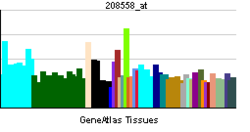- OR10H1
-
Olfactory receptor, family 10, subfamily H, member 1 Identifiers Symbols OR10H1; OR19-25; OR19-26 External IDs HomoloGene: 115504 GeneCards: OR10H1 Gene Gene Ontology Molecular function • receptor activity
• olfactory receptor activityCellular component • plasma membrane
• integral to membraneBiological process • sensory perception of smell
• response to stimulusSources: Amigo / QuickGO RNA expression pattern 
More reference expression data Orthologs Species Human Mouse Entrez 26539 100038859 Ensembl ENSG00000186723 ENSMUSG00000079309 UniProt Q9Y4A9 n/a RefSeq (mRNA) NM_013940 NM_010998.2 RefSeq (protein) NP_039228 NP_035128.2 Location (UCSC) Chr 19:
15.92 – 15.92 MbChr 17:
33.31 – 33.31 MbPubMed search [1] [2] Olfactory receptor 10H1 is a protein that in humans is encoded by the OR10H1 gene.[1]
Olfactory receptors interact with odorant molecules in the nose, to initiate a neuronal response that triggers the perception of a smell. The olfactory receptor proteins are members of a large family of G-protein-coupled receptors (GPCR) arising from single coding-exon genes. Olfactory receptors share a 7-transmembrane domain structure with many neurotransmitter and hormone receptors and are responsible for the recognition and G protein-mediated transduction of odorant signals. The olfactory receptor gene family is the largest in the genome. The nomenclature assigned to the olfactory receptor genes and proteins for this organism is independent of other organisms.[1]
Contents
See also
References
Further reading
- Fuchs T, Malecova B, Linhart C, et al. (2003). "DEFOG: a practical scheme for deciphering families of genes.". Genomics 80 (3): 295–302. doi:10.1006/geno.2002.6830. PMID 12213199.
- Malnic B, Godfrey PA, Buck LB (2004). "The human olfactory receptor gene family". Proc. Natl. Acad. Sci. U.S.A. 101 (8): 2584–9. doi:10.1073/pnas.0307882100. PMC 356993. PMID 14983052. http://www.pubmedcentral.nih.gov/articlerender.fcgi?tool=pmcentrez&artid=356993.
- Grimwood J, Gordon LA, Olsen A, et al. (2004). "The DNA sequence and biology of human chromosome 19". Nature 428 (6982): 529–35. doi:10.1038/nature02399. PMID 15057824.
External links
This article incorporates text from the United States National Library of Medicine, which is in the public domain.
Class II
(tetrapod specific receptors)Family 1Family 2A1 · A2 · A4 · A5 · A7 · A12 · A14 · A25 · A42 · AE1 · AG1 · AG2 · AJ1 · AK2 · AP1 · AT4 · B2 · B3 · B6 · B8 · B11 · C1 · C3 · D2 · D3 · F1 · F2 · G2 · G3 · G6 · H1 · H2 · J1 · J2 · J3 · K2 · L2 · L3 · L5 · L8 · L13 · M2 · M3 · M4 · M5 · M7 · S2 · T1 · T2 · T3 · T4 · T5 · T6 · T8 · T10 · T11 · T12 · T27 · T29 · T33 · T34 · T35 · V1 · V2 · W1 · W3 · W5 · Y1 · Z1
Family 3Family 4Family 5Family 6Family 7Family 8Family 9Family 10Family 11Family 12Family 13Categories:- Human proteins
- Transmembrane receptor stubs
- G protein coupled receptors
Wikimedia Foundation. 2010.
